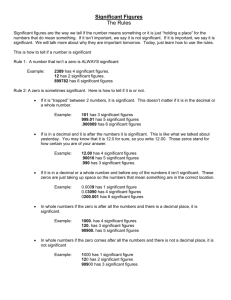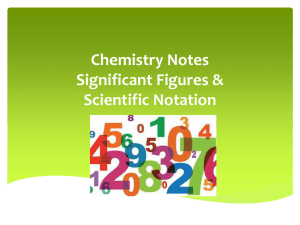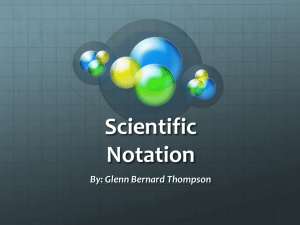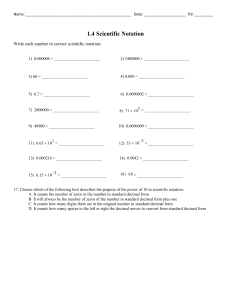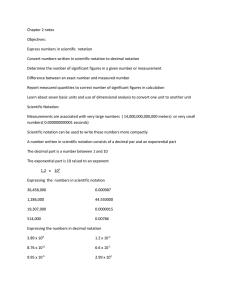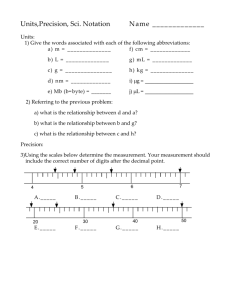Matter & Measurement Section 1-1: Matter
advertisement
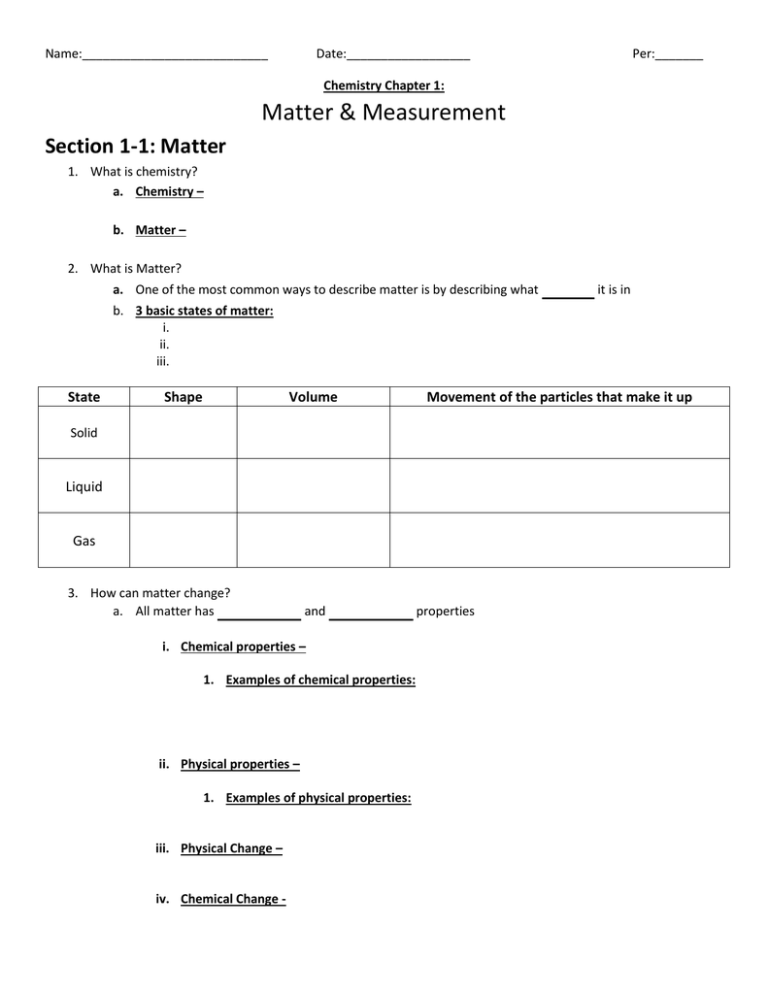
Name:___________________________ Date:__________________ Per:_______ Chemistry Chapter 1: Matter & Measurement Section 1-1: Matter 1. What is chemistry? a. Chemistry – b. Matter – 2. What is Matter? a. One of the most common ways to describe matter is by describing what state it is in b. 3 basic states of matter: i. ii. iii. State Shape Volume Movement of the particles that make it up Solid Liquid Gas 3. How can matter change? a. All matter has chemical and physical properties i. Chemical properties – 1. Examples of chemical properties: ii. Physical properties – 1. Examples of physical properties: iii. Physical Change – iv. Chemical Change - m D= v 4. Sample Density problems: a. What is the density of a paperclip who’s mass is 1g and volume is 2mL? i. Identify units: ii. Plug in units to equation: iii. Solve equation: b. What is the density of a piece of cork who’s volume is 15ml and mass is 30g? i. ii. iii. c. What is the mass of a box that occupies a volume of 100ml and has a density of 10 g/mL? i. ii. iii. Section 1-2: Types of Matter 5. What is matter made out of? a. All matter is composed of one or a combination of atoms b. Atom – c. When atoms bond together they make molecules d. Moleculese. Matter can consist of only one atom or molecule or a mixture of atoms and molecules 6. What are pure substances? a. Pure substances – i. Two main types of pure substances are Elements and Compounds ii. Element – 1. How are elements represented? 2. What lists all the known elements? iii. Compound – 1. How are compounds represented? 7. What are mixtures? a. Mixture – i. What are two types of mixtures? ii. Homogeneous Mixture – 1. Examples of homogeneous mixtures: iii. Heterogeneous Mixtures – 1. Examples of heterogeneous mixtures Section 1-3: Measuring Matter 8. How do we measure matter? a. The Metric System - i. Base metric measurements: Base Measurement For: Base Unit Abbrev. Mass ii. iii. Length Volume Amount of a substance 9. Because the metric system is based on powers of 10, simple metric conversions can be made by moving the decimal place back and forth on the metric number line: 10. Practice metric conversions: a. 152 m = _______________km e. 163 hm = _______________m = _______________L b. 0.0015 hm = _______________cm f. 417 mL c. 12 dm = _______________m g. 73 cm = _______________m d. 1.92 dm = _______________km h. 29 mg = _______________kg 11. What is a mole? a. A mole is a word for a number of things. Just like a dozen is 12 or a single is 1. b. Mole (Molecular unit) – 6.02x1023 (602,000,000,000,000,000,000,000 or 602 sextillion) c. What is a mole used for in chemistry and why? 12. Using scientific notation with moles. a. To express very large numbers like moles, and very small numbers chemists use scientific notation b. Scientific notation condenses large or small numbers by numerically stating what power of ten you must multiply a number by in order to get the true numbes i. 365,000,000,000 3.65 x 1011 ii. 0.00000052 5.2 x10-7 iii. 602,000,000,000,000,000,000,000 6.02x1023 c. There are 3 rules when using scientific notation i. ii. iii. Express the following numbers using scientific notation: 2700 0.0035 8,000,000 0.010 13. How do you work with Scientific notation? a. In your calculator you must use the scientific notation key and PARENTHESIS b. Scientific notation key: i. May be a “second” function ii. The button could be labeled iii. It isn’t the e button , , or 6.02𝑥1023 = 3.01𝑥1023 2𝑥104 𝑥 2.00𝑥10−4 = 4.7𝑥106 − 4.401𝑥106 = 1𝑥106 + 3𝑥108 = ANSW: 2.99x105 , 2 , 3.01x108 , 4 14. Number Conversions a. What is dimensional analyses? b. How does dimensional analyses work? c. Ex: How Km is 56 feet? (1 m = 3.2ft & 1 km = 1000m) 56 ft 1m 1km 56 ft x x x1x1 1 3.2 ft 1000m 1 d. Steps for performing dimensional analysis: i. ii. iii. Convert 15 g to kg: Convert 20ml to kl: How many seconds are there in a year? How many atoms is in 4 moles of C: Section 1-4: Measurements & Accuracy 15. Accuracy and significant figures a. What do chemists use to determine the accuracy of a number? b. How do you determine the number of significant digits a number has? 16. Atlantic pacific rule: a. If a decimal point is Present, ignore zeros on the Pacific (left) side. b. If the decimal point is Absent, ignore zeros on the Atlantic (right) side. c. Everything else is significant Number 0.001010 0.30000 100.0000 12303000 12303000.0 23000 Atlantic – Pacific Rule Decimal point Present: Ignore zeros on the Pacific side. Decimal point Present: Ignore zeros on the Pacific side. Decimal point Present: Ignore zeros on the Pacific side (none!) Decimal point Absent: Ignore zeros on the Atlantic side. Decimal point Present: Ignore zeros on the Pacific side none. Decimal point Absent: Ignore zeros on the Atlantic side. Number of Significant Figures 4 sig. digits. 0.001010 5 sig. digits. 0.30000 7 sig. digits. 100.0000 5 sig. digits. 12303000 9 sig. digits 12303000.0 2 sig. digits 23000 d. Which of the above numbers is most accurate? How do you know? e. How do you do arithmetic with significant figures?


